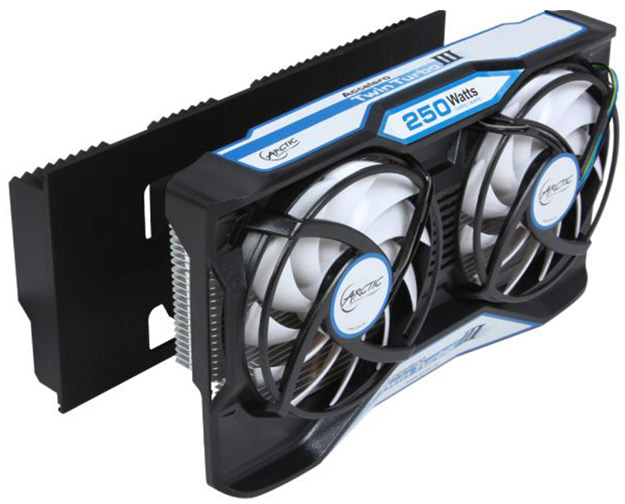Quieting A Noisy Graphics Card With An Aftermarket Cooler
Quieting A Noisy Graphics Card
Professional system builders are usually obsessed with silence and cooling. Custom cooling solutions are some of the biggest differentiators in pre-built systems. And one of the chief selling points of aftermarket cooling gear for enthusiasts is noise output, usually listed in decibels. There are even companies, like "be quiet!" for example, that focus on noise output as a main selling point for entire line-ups of cases, power supplies, and heat sinks.
CPUs and GPUs are typically what get the most attention when it comes to aftermarket cooling. Stock coolers on GPUs usually do an adequate job, but there exists a decent aftermarket for GPU coolers, usually reserved for overclockers who like to jack their GPU frequencies up as high as possible. But many users seek out aftermarket coolers to quiet down their graphics cards as well.
While our own Marco Chiappetta had a good experience with the reference cooler on the GeForce GTX 670, many of the cards -- regardless of vendor -- have a bad reputation for being very loud under load, with an annoying buzz associated with the noise output. This video shows how bad it could get, and the reader comments make it clear it's a common problem. Under full load, my PNY GTX 670 would get almost as bad as the one in the video.
It wasn't hard to generate that kind of noise, either. My PC runs World Community Grid as I try to help life sciences (and I use the GPU for the utility, so it was not the CPU cooler making the noise), and I play a variety of action games. All I had to do was fire up World of Warcraft while leaving WCG running and that card sounded like an airplane engine. Even though WCG is supposed to scale back when another application takes focus, my Rainmeter monitors told me it was still running, grabbing GPU cycles when it could.
So, when I upgraded to an ASUS STRIX GTX 970, the sound of silence was a blessing. The fans don't kick in until the GPU hits 60'C and that rarely happens. When it does, the fans are dead quiet.
The GTX 670 is still a decent graphics card for 1080p gaming and general computing tasks, so upgrading my main rig also gave me the opportunity to experiment with an aftermarket cooler and see if I could silence that noisy 670 card.
The GTX 670 is still a decent graphics card for 1080p gaming and general computing tasks, so upgrading my main rig also gave me the opportunity to experiment with an aftermarket cooler and see if I could silence that noisy 670 card.
The cooler of choice was Arctic's Accelero Twin Turbo III, available for about $55 at various resellers. It promises to fit practically every card on the market and has a 6-year warranty, so I bit despite the somewhat hefty price tag.
Tearing Down, Rebuilding The GTX 670
The PNY card came apart easily. All I needed to do was remove about 10 screws from the back, all of them on the PCB itself, plus two on the underside of the card. The cooler, for all its faults, fit very nicely over one side of the card and extended back a bit.
After dissecting the card it became apparent just how small the GTX 670 is. The cooler practically doubles the length of the card.
Turning my attention to the Twin Turbo, two things became immediately apparent: one, it would not neatly cover the card the way the stock cooler did. The heat sink part would sit on the GPU much like a CPU cooler does, but that would leave a lot of open space between the cooler and the card's PCB.
That wasn't a big deal. What was a big deal, however, was the atrocious documentation. This is a process not to be taken lightly, and this cooler is designed for a multitide of graphics cards, running both NVIDIA and AMD GPUs, which meant different design form factors, mounting locations, etc.
In the package was a basic, fold out sheet with a lot of pictures and very few words that didn't offer very much help at all. Fortunately, more thorough documentation is also online, that's a little more verbose, so I was able to perform the surgery without a hitch.
After dissecting the card it became apparent just how small the GTX 670 is. The cooler practically doubles the length of the card.
Turning my attention to the Twin Turbo, two things became immediately apparent: one, it would not neatly cover the card the way the stock cooler did. The heat sink part would sit on the GPU much like a CPU cooler does, but that would leave a lot of open space between the cooler and the card's PCB.
That wasn't a big deal. What was a big deal, however, was the atrocious documentation. This is a process not to be taken lightly, and this cooler is designed for a multitide of graphics cards, running both NVIDIA and AMD GPUs, which meant different design form factors, mounting locations, etc.
In the package was a basic, fold out sheet with a lot of pictures and very few words that didn't offer very much help at all. Fortunately, more thorough documentation is also online, that's a little more verbose, so I was able to perform the surgery without a hitch.







